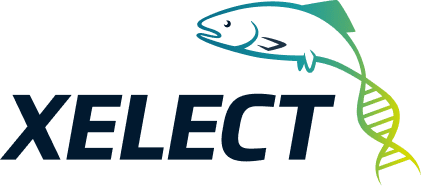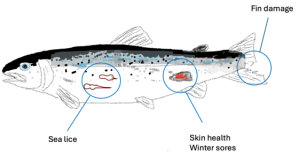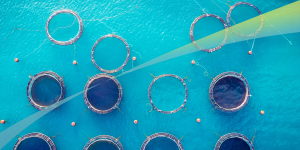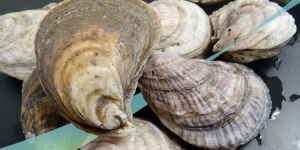
Welcome to the first edition of Insights with Ian, a new blog series from Xelect’s founder and aquaculture visionary, Ian Johnston. Each month, Ian will dive into the technologies and trends shaping the future of aquaculture.
In this issue, we take a closer look at the rise of precision aquaculture and its transformative impact on the industry.
The rise of precision aquaculture
The “internet of things” and advances in computing, particularly artificial intelligence (AI), are transforming Society more fundamentally and at a pace not seen since the original industrial revolution (1750-1900). In agriculture, the use of Precision Farming Technologies is driving increased yields of crops and animals and more efficient production. Real time data from a vast array of sensors and image detection systems can be transmitted to cloud systems and analysed using machine learning models, simulations and decision-making algorithms. Wearable sensors attached to individual livestock can detect sound, measure body temperature, sweat, saliva, heart rate, and movement. Applications include the early detection of disease, the optimisation of feeding and the automated monitoring of animal welfare.
Similar technologies are being introduced to the net pen farming of Atlantic salmon and other fish species. Multiple data streams from cameras, acoustic, temperature, oxygen and turbidity sensors across multiple pens and sites are relayed to a central control room for analysis. The accumulation and analysis of massive amounts of data over time is expected to lead to better management decisions and a step change in production efficiency. The Mowi 4.0 “Smart Farming” initiative in collaboration with Tidal is already available at multiple sites in Norway.
What is precision aquaculture?
The core application of computer vision and AI in aquaculture involves the use of multiple stereoscopic cameras to identify fish boundaries and anatomical landmarks, allowing the weight and length of thousands of fish in a net pen to be continuously measured. Other sensors provide information on temperature, oxygen levels, salinity and water currents (see Fig. 1).
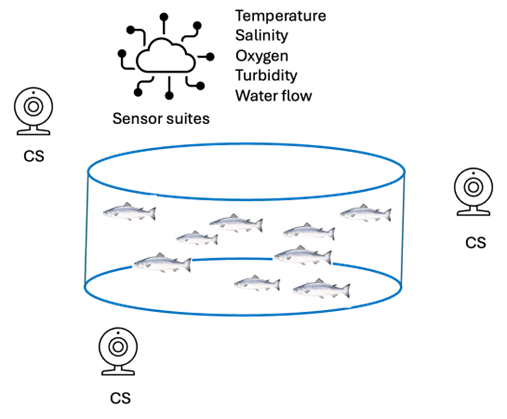
Fig. 1 An automated fish pen sends multiple data streams to the “cloud”. CS: camera systems.
Leading companies in the sector include Ace Aquatec, OptoScale and Tidal which is owned by Google. Measurement accuracy of automated systems is superior to the periodic manual sub-sampling of a relatively small number of fish from each net pen and has the advantage that it does not stress the fish or disturb growth and has lower labour costs. Technical innovations include the use of self-cleaning lenses and sensors using UV light to inhibit the buildup of algae and fouling organisms enabling long term operation and low maintenance. Information on fish weight distribution is valuable for identifying the best time for grading and/or harvesting. Optimising weight classes in a pen helps to reduce food waste and feed costs. Other applications include the monitoring of swimming and feeding behaviour by integrating and analysing visual and acoustic data. Such data can increase the efficiency of feeding and provide an early indication of health and welfare issues. It also possible to identify salmon using their unique skin patterning so that individual growth rate can be measured in addition to biomass distribution in the net pen. The large-scale automated collection of phenotype information of all kinds is known as phenomics. Computer models with decision making capabilities have the potential to use multi-year data sets of environmental conditions, feed, health interventions, and growth to improve outcomes and profitability on the farm.
Other benefits of automation
Regulatory compliance
Maturation is undesirable in salmon net pen farming because it lowers the sale value of the fish and raises the environmental impact of escapees. In some jurisdictions there is a regulatory requirement to report rates of sexual maturation which involves the slaughter and dissection of up to 200 fish per site. Recently, Aquabyte has received approval from the Icelandic Food and Veterinary Authority in Iceland for an automated non-invasive method for estimating sexual maturation in farmed salmon involving computer vision and AI. This phenomics solution allows companies to meet regulatory requirements without harming or stressing the fish.
Health and welfare
Computer vision and machine learning using large training data sets validated by veterinary diagnosis can be used to effectively monitor health status including parasites, skin lesions and fin damage leading to bacterial infections (Fig. 2).
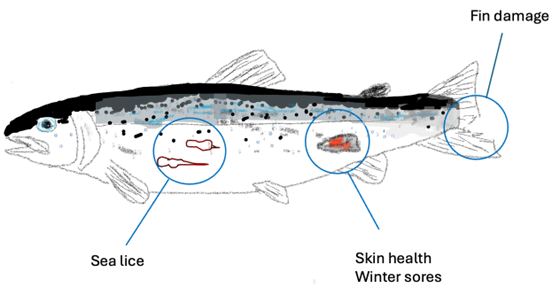
Fig. 2. Machine learning software can learn to recognise parasites and diseases affecting the skin.
Sea lice reduce growth and cause significant mortality and high treatment costs, estimated at 6 billion NOK/year in Norway. Sea lice can be quantified continuously from images of skin enabling early intervention and more cost-effective management of the parasite. Stingray have developed stereo machine vision and software to identify and count ectoparasites, such as sea lice, on salmon and trout. Precision lasers can then then target and kill the parasites without harming the fish.
Ventilation rate can change rapidly due to stress from jellyfish or predator incursions or more slowly due to seasonal changes or the onset of disease, particularly gill pathogens such as amoebic gill disease (AGD). Currently, monitoring gill health requires handling and sedating fish which causes stress and is costly. Real time measurements of ventilation rate have the potential to predict which pens should be prioritised for manual inspections for gill health allowing timely management action. Folkman et al. (2025) have reported a fish head detection model, using video at 30 frames which classifies the mouth state as either open or closed using a convolutional neural network. Multiple object tracking is then used to create temporal sequences of fish swimming across the view of the underwater camera enabling ventilation rates to be estimated as an index of gill health and potentially stress due to high summer sea temperatures, which are becoming more frequent as the climate warms.
Automation has the potential to identify those net pens that require health treatments or management interventions.
Harvesting
Phenomic approaches could also be employed to measure phenotypes at the harvesting stage as an alternative or to supplement data from net pens. Currently, carcass quality traits including skeletal deformities, colour, fat content, fatty acid composition, omega-3 contents, dressing percentage, visceral fat content, flesh texture, fillet yield and propensity for gaping are necessarily measured on slaughtered individuals. Automated methods are widely used to harvest and humanely kill fish involving pumps and electrical stunners. Pumps constrain the aspect of the fish and may allow time of flight cameras and AI software to obtain measurements of weight, length and condition index. NOFIMA have reported the use of hyperspectral cameras and AI software to accurately measure fat levels in different body compartments in thousands of fish, allowing estimates of total and visceral fat. Similarly, high resolution NMR could be used to measure omega 3 polyunsaturated fatty acid content which is one of the many benefits of salmon to the human diet.
Genetics and breeding
Phenomics will increasingly complement advances in genomics to improve breeding decisions leading to faster genetic progress. It will increase the amount, range and quality of phenotype data as well as allowing novel traits of high economic value to be included in the selection index e.g. disease resistance traits. Importantly, breeding applications will often be able to utilise existing investment in IT infrastructure made by production. The possibilities of phenomics for improving genetics is an exciting area for Xelect which will be the subject of a future blog.
Beyond salmon
Although the highly industrialised and consolidated salmon sector is at the forefront of the application of AI and phenomics to aquaculture the same approaches and technologies will likely find their way to the net pen farming of other species such as sea bass, sea bream and tilapia. Early applications in shrimp farming include biomass estimation, feeding optimisation and health assessment e.g. Sincere Aqua. The Alfred Wegener Institute in Germany is leading a R & D consortium also involving Oceanloop that seeks to optimise phenomics technologies for land based shrimp culture.
Final thoughts
Advances in digitalisation and automation will undoubtedly enhance productivity and efficiency on industrial fish farms over the next decade and beyond.
However, the use of IT and automation will also make aquaculture production more fragile than in the past and at greater risk of catastrophic loss due to cyber-attack or failure of the power grid. Investments in resilience such as cyber security and off-grid back up of critical data such as genotype and phenotype records will need to be given high priority.
Aquaculture production and breeding stand on the brink of revolutionary change which has the potential to boost sustainably, profitably and welfare standards. In my view the companies that embrace and master precision farming and breeding techniques are the ones who will be successful in the future.

